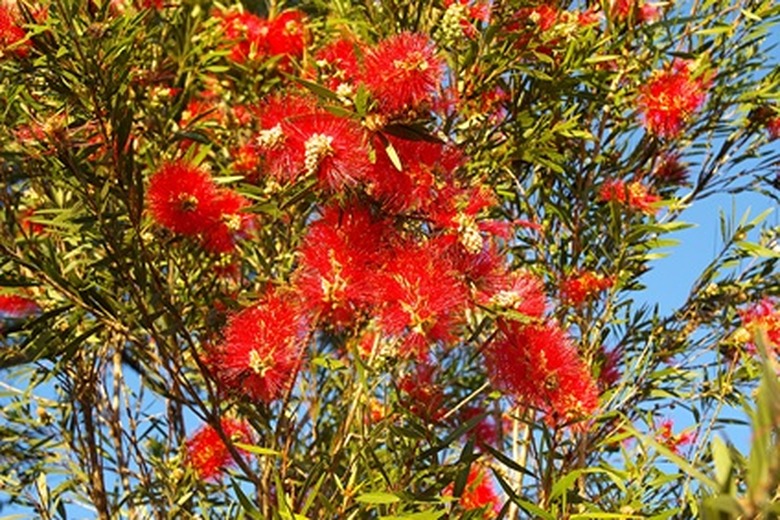Bottlebrush Species
Bottlebrush species are plants with interestingly shaped flowers that attract wildlife to the garden. Identify different types of bottlebrush plants for an understanding of their habits and diversity in color. Bottlebrush plants add a distinct aesthetic impact as well as a vivid splash of color to a gardening space.
Care Requirements
Bottlebrush species (Callistemon species) perform well in full sun. Native to Australia, this plant thrives in temperate climates; temperatures that drop below 20 degrees F cause extensive damage to bottlebrush. Grow in well-drained soil and take care to avoid extremely alkaline soil; though bottlebrush tolerates alkalinity, chlorosis may occur, according to the University of California IPM Online.
Ornamental Features
Bottlebrush plants are evergreen and considered large shrubs or small trees, according to the University of California IPM Online. Often used in the landscape as a hedge or specimen plant, bottlebrush displays flowers that, as the name suggests, resemble cleaning brushes used to clean the insides of bottles. The flowers are cylindrical bristle-covered blooms with colors ranging from reds to whites. Bottlebrush grows to a height of 6 to 25 feet with a width of 5 to 20 feet, according to the University of California Agriculture and Natural Resources.
- Bottlebrush species are plants with interestingly shaped flowers that attract wildlife to the garden.
- Native to Australia, this plant thrives in temperate climates; temperatures that drop below 20 degrees F cause extensive damage to bottlebrush.
Species and Cultivars
Bottlebrush plants come in 34 species, according to the University of Florida IFAS Extension. The most well-known species is crimson bottlebrush (Callistemon citrinus) often found in coastal areas of the southern United States. Callistemon viminalis, referred to as weeping bottlebrush, is a species that reaches up to 30 feet tall with a spread of 20 feet. The tree takes on a weeping habit and displays red flowers. A cultivar of Callistemon citrinus, Little John, is a dwarf bottlebrush that displays vivid red flowers. This shrub has blue-green foliage and remains low to the ground at a height of 3 feet with a width of 5 feet, according to the University of Florida Nassau County Extension.
Problems
Bottlebrush species suffer from environmental problems because, as a subtropical plant, they are often grown in inappropriate cultural conditions. Frost can severely affect or kill bottlebrush plants. An insect pest problem that affects bottlebrush is an infestation of scales. Armored scales are immobile and without legs, so identification can be tricky. Look for ovular to round bumps on plant surfaces. Scales are "sucking" bugs that feed on plant fluids; the release of honeydew, a sugary substance excreted during feeding, creates a prime environment for sooty mold. The black-hued mold is a secondary sign that a scale problem is affecting your bottlebrush plant. Look for distorted plant parts, wilt, yellowing, leaf drop or a gum-like substance on plant surfaces. Plants may end up in decline or will face death, according to the University of California IPM Online.
- Bottlebrush plants come in 34 species, according to the University of Florida IFAS Extension.
- A cultivar of Callistemon citrinus, Little John, is a dwarf bottlebrush that displays vivid red flowers.
Treatment
To control common bottlebrush species problems, plant this shrub in regions that do not experience extremely cold conditions. For scale management, release predatory insects like lady beetles into the infested area; available through garden supply providers, predatory insects hunt and kill scales. For a severe problem, apply horticultural oil to your bottlebrush species on a dry day as a control method for scale.
